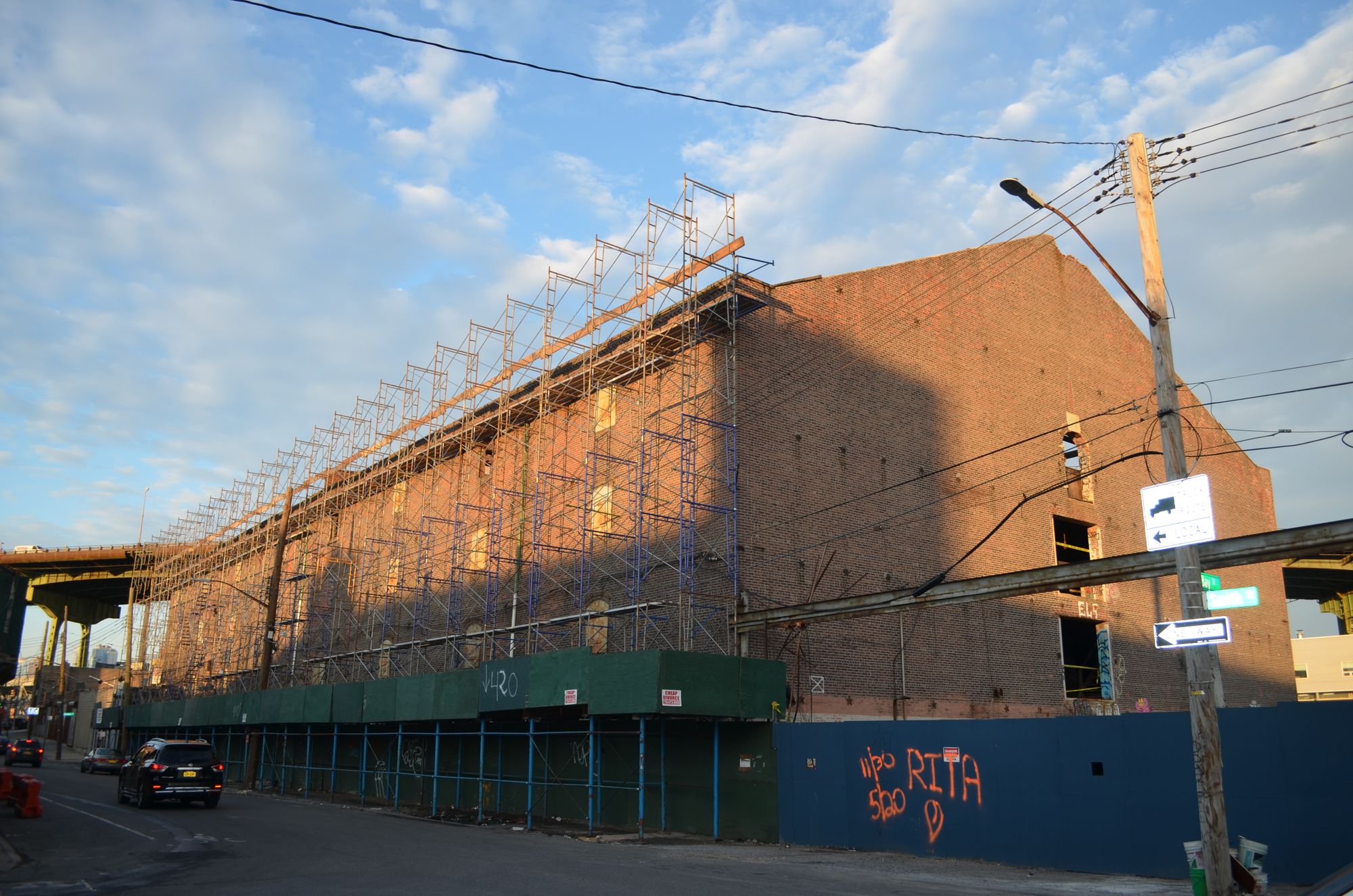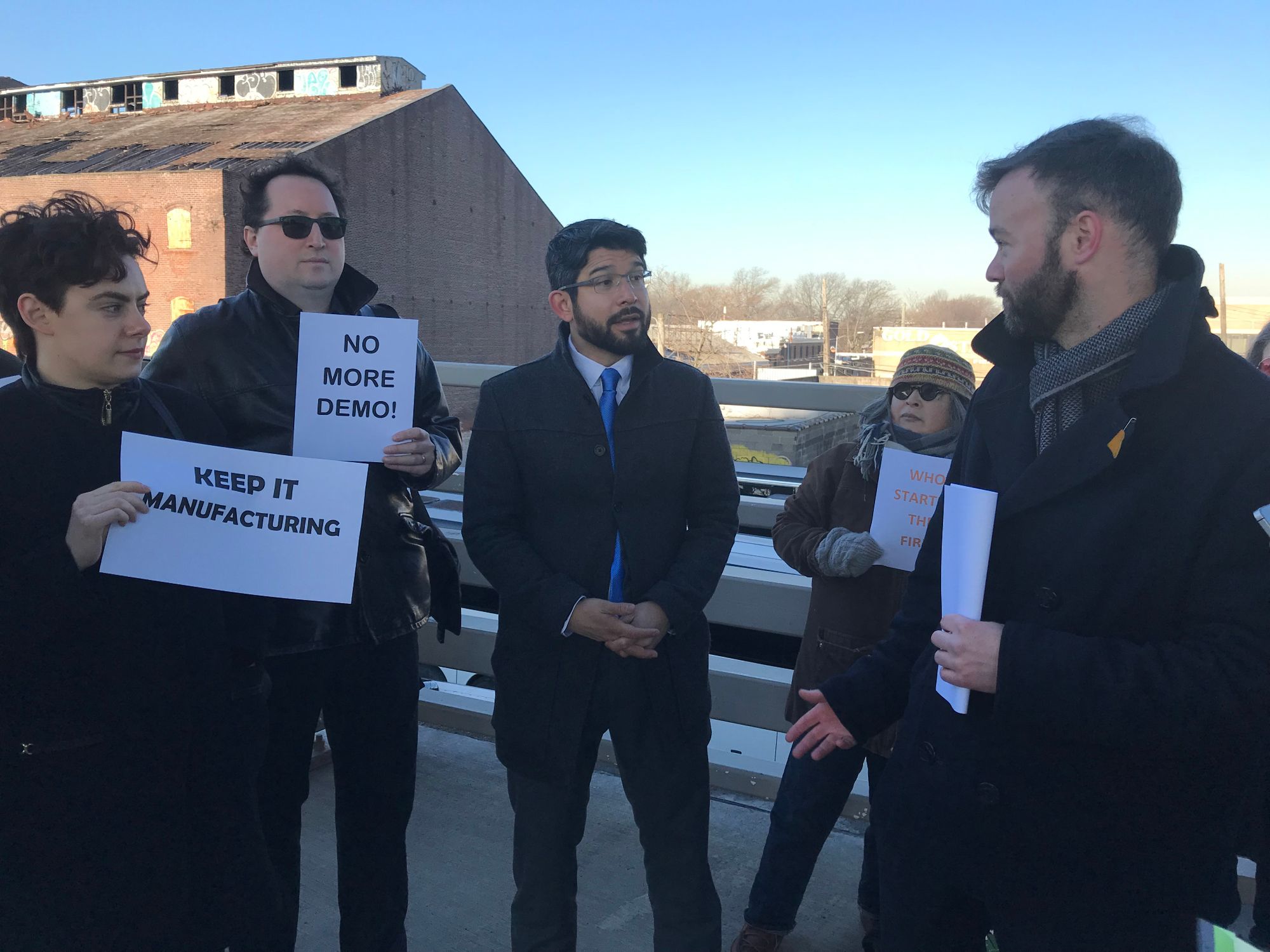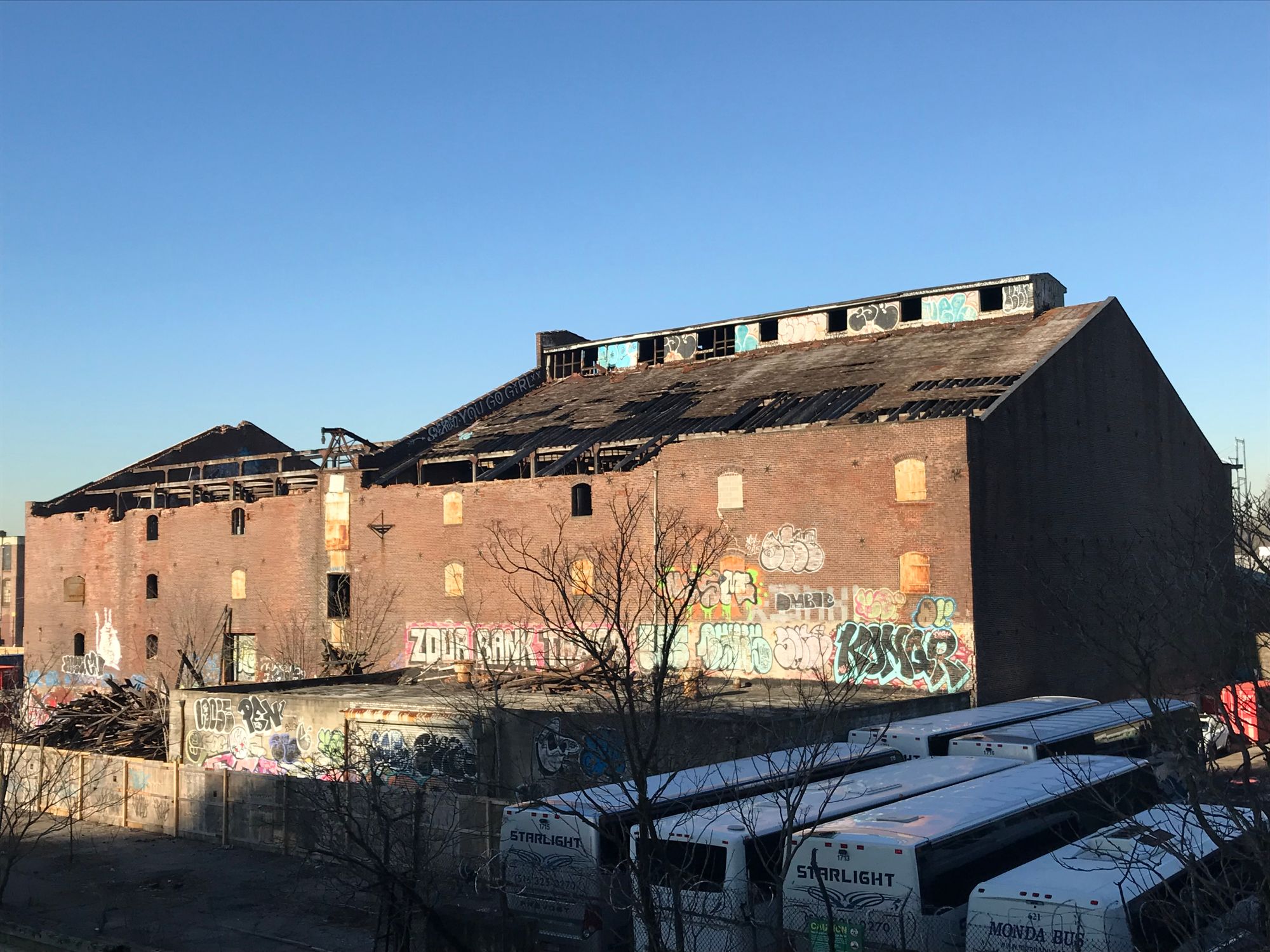DOB To Issue A Criminal Court Summons Against Developer Of S.W. Bowne Grain Storehouse

[UPDATED: Wednesday, March 13, 2019 at 5pm] The NYC Department of Buildings [DOB] reached out to Bklyner with the following clarifications.
“DOB has issued several violations to the building owner already for failure to comply with a DOB issued Stop Work Order,” wrote Andrew Rudansky, DOB Senior Deputy Press Secretary. “If the property owner continues to disregard DOB orders, we may take enhanced enforcement actions, including possibly issuing a criminal court summons.” Rudansky noted that the department has not yet issued a criminal court summons to the owner of 595 Smith Street.
In regards to the Stop Work Order, Rudansky stated that it was “actually issued back” on June 20, 2018 for 595 Smith Street, “after DOB inspectors observed demolition work taking place without a proper DOB permit.” This Stop Work Order remains in effect.
“Following this, the property owner applied for the demolition permit they need to take down the building, and after the application was found by DOB to comply with the Code and applicable zoning,” the department issued a demolition permit on February 7, 2019, according to Rudansky.
DOB issued a violation to the site on Tuesday, March 5, 2019 after inspectors “observed work ongoing at the site contrary to that active Stop Work Order.” The department issued a second violation for the same issue later that week on Saturday, March 9, 2019, he added.
RED HOOK – The Gowanus Landmarking Coalition held a press conference Wednesday morning to protest the planned demolition of the S.W. Bowne Grain Storehouse (595 Smith Street)—the historic building that is currently under investigation by the FDNY following a suspicious fire there last summer.

The Coalition sent a notice over the weekend showing photos of demolition scaffolding going up around the 133-year-old structure at 595 Smith Street.
“Something is off here and we are going to contact the FDNY and DOB to understand what’s happening on their end. Our commitment to preserving the warehouse has not wavered,” a spokesperson for City Council Member Carlos Menchaca, whose district covers Red Hook, said in response to the Coalition’s notice.

Council Member Menchaca joined the Coalition Wednesday morning on the Hamilton Avenue Bridge overlooking the Bowne Storehouse and provided an update on his recent discussions with the Department of Buildings [DOB] who granted a demolition permit for the site on February 7, 2019, which was followed by a Stop Work Order issued on March 5, 2019.
“As of yesterday afternoon, the Department of Buildings says that their borough attorney is commencing a process to issue a criminal court summons based on repeated violations,” Menchaca said. “We are still trying to get clarity on what that enforcement timeline looks like. Until then we must not relent until demolition stops and the preservation of this gorgeous, beautiful building commences.”
The June 14, 2018 fire at the site is still under investigation, however it has been “determined to be an incendiary [involving arson] fire,” a FDNY spokesperson said on Monday. Bklyner followed up with the FDNY to inquire whether a property owner can demolish a building when it is under investigation, but has not received a response yet.
“The FDNY asserted last year that the fire appeared to be intentionally set, and we knew that. All you had to do was look at the building….” Menchaca continued. “And despite the Stop Work Orders, demo crews have been active.”

“This is highly suspicious, and it’s wrong,” the Council Member stressed. “The FDNY must be allowed to complete its investigation but it has also been several months since it started. So they’re in process right now and we cannot wait to preserve a building of such historic importance. We have to do that now.”
The Executive Director of the Historic Districts Council, Simeon Bankoff, noted the Greenpoint Terminal Market as another example of a historic waterfront property that went up in flames under questionable circumstances. “When the Greenpoint Terminal Market burned about 13 years ago, just like this was set, we lost a real opportunity there to reuse that wonderful complex. We cannot lose the opportunity here. We can’t reward bad owners for actually setting fire to their own property because they aren’t getting what they want,” he said.

“This is not a new situation,” Bankoff told Bklyner. “The Historic Districts Council has been asking for this building and others like it in Gowanus to be preserved since 2011, and we were late to the party. People have been aware of this building for decades. They’ve been asking for it to be preserved. And now, to have a situation where there is a suspicious fire and the owners get permission to demolish afterwards while there still is, as we understand, an open investigation beggars the imagination” he said.
In May 2018, Brooklyn Community Board 6 wrote a letter to the Landmarks Preservation Commission and NYC Department of Buildings supporting requests to consider landmarking the building and requesting that DOB refrain from issuing further permits that would alter the “exterior historical character or structural integrity” of the property. Read the letter here.
Bankoff said the S.W. Bowne Grain Storehouse facility is the last of its kind, “There used to be others like that, this is the last remaining…. It is actually a tangible reminder of the original use of the Gowanus and the original use of the canal, and to lose it is to lose a real piece of our history.”
He also discussed the possibility of preserving the Bowne building under adaptive reuse. “The Brooklyn waterfront was one of the major arteries that helped build this city into the world power it is,” Bankoff said. “At one point, easily, a quarter of all the processed goods in America passed through the Brooklyn waterfront…. One of the great marvels of Brooklyn, of New York City is the adaptive reuse of the historic properties of the waterfront. They’re being reused for shopping, they’re being reused for light industry…. The Fairway in Red Hook is one example of a warehouse building being reused for the continued distribution of consumer goods.”
“We’re talking about claiming the historic properties of the Brooklyn waterfront to be reused, to be recycled, to be used in ways that benefit Brooklyn sustainably,” Bankoff said.

Council Member Menchaca also noted at the press event that early on in his first term as City Council Member, the developers of the Bowne site, the Chetrit Group, presented rezoning plans to him along with drawings of residential towers for the 595 Smith Street site. Menchaca told them that the site was located in a manufacturing district and requested revised plans. Chetrit Group returned with drawings of two levels of manufacturing space topped with residential towers. “That is not what we want on this site. We want to preserve the manufacturing,” Menchaca said.
“Greed blinds the heart and the mind, but it also has impact in our neighborhoods and that’s what we’re seeing right now,” the Council Member added.
“People can make more money if they build upwards, it’s a very simple calculation,” said Joseph Alexiou, author of Gowanus: Brooklyn’s Curious Canal. “All they do is wait around for the zoning to change. That kind of speculation has been affecting adversely the development of Brooklyn since it was conceived of as a city in the 1830s. The problem with New York is that there’s so much money here that any time the chance of making more happen, we get inundated with speculation, and that is what drove these owners to do bad things to their own buildings. Literally you threw the baby out, not into bath water but into a fiery pit.”
Alexiou, who had the chance to tour the S.W. Bowne Grain Storehouse with journalist Nathan Kesinger in 2015 was taken by “the graffiti art in there, the structure in itself, the historic signs in there in multiple languages….”
He agrees that the building should be adaptively reused rather than demolished, suggesting it be restored for nightlife, restaurant, manufacturing, or office uses, pointing to the nearby IKEA and Home Depot as successful examples of reusing an existing warehouse structure. “I see the potential of history preserved and then brought into the 21st century all encapsulated in one gorgeous, derelict structure. That’s the story of New York City,” Alexiou said.



